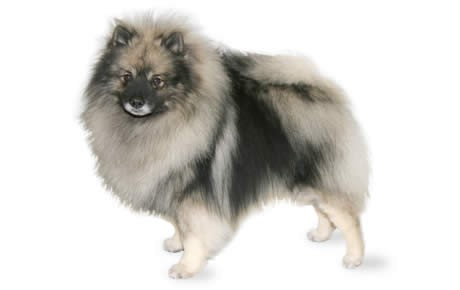Keeshond Breed Guide

Breed Group:
Companion Dogs
Get 30% off
Join our Newsletter
Sign Up Today
Keeshond Background & History
Although the background of the Keeshond breed is not for certain, historians believe that these dogs came from Holland back in the 16th century. During this time, locals used Keeshonds as trusted watch dogs for their homes and on barges.
Interesting enough, this breed became a popular symbol of a political uprising when one of the leaders owned a Keeshond dog. Unfortunately, when the rebels lost the uprising, many Keeshond dogs were abandoned by their owners, in fear that they would be associated with the opposition. If it wasn’t for several barge owners who loved this breed, the Keeshond would have become extinct within the following years.
In 1923, the first Keeshond was brought to America. Within the next 10 years, this breed was recognized by the AKC as an official breed. Even though Keeshonds may not be very popular, they are Holland’s national dog, and they are still a popular pet in their home country today.
Keeshond Personality
Unlike most breeds, Keeshonds don’t feel the need to be doing a job at all times. Even though they have served as a successful watchdog in the past, they are more bred for companionship and prefer to be by their owner’s side whenever possible.
This breeds is also very playful and will be easily excited by new friends and other pets as soon as they enter a room. As long as they are getting some attention and playtime in on a daily basis, the Keeshond will be one happy pup!
Keeshond Training Tips
With a little practice and consistency, the Keeshond can be a delightful breed to train. They are highly intelligent and are able to pick up simple commands in no time at all.
However since they are so smart, they can quickly become bored if they are not being challenged enough. That’s why it’s important to switch up your lessons with engaging games and activities that are both exciting and different.
Training efforts for a Keeshond should also include socialization. Starting at a young age you should introduce them to different people, places, and experiences so they become a well-rounded and behaved pup later on in life.
Keeshond Exercise Needs
Unlike most breeds, Keeshonds do not require a lot of physical activity on a daily basis. While they love to run in the yard or play a game of fetch with the kids, that’s about all they need to stay happy and healthy.
It’s also important to note that the Keeshond breed does not handle hot climates very well. They would way rather walk in the crisp air than on a scorching hot day. Make sure to keep this in mind before adopting a Keeshond into the family.
Keeshond Lifespan
The average lifespan of the Keeshond dog breed is between 13 to 15 years of age.
Keeshond Breed Popularity
The Keeshond is loved for their affectionate qualities and playful personalities which makes them an excellent companion for any household. Today, the American Kennel Club ranks this dog as the 92nd most popular dog breed in the United States.
Keeshond Feeding Requirements
On average, a Keeshond should consume between 1 to 2 cups of high-quality food, split into two equal meals. Keep in mind that your dog’s age, metabolism, activity rate, and size should all be considered when creating a proper feeding regimen for him. Consult with your veterinarian for additional guidance.
Keeshond Grooming
With their fluffy thick coat and a characteristic main, Keeshonds have a distinctive look that makes them completely unique to most other breeds. Even though hard to believe, their iconic coat is fairly easy to maintain and doesn’t require a strict grooming regimen.
Professionals recommend brushing your pup at least twice a week to keep his coat in great condition. It is also important to brush his teeth at least once a week in order to prevent bacteria from building up. Lastly, if your dog does not wear down his nails naturally, trim them down every couple of weeks to prevent breakage or cracking.
Are Keeshonds Good with Kids?
Due to their playful spirit and medium-sized built, the Keeshond is known to be an excellent pet for a family with kids. Keep in mind that it is always a good idea to have an adult present during any interactions. Once the child knows how to properly care for and treat a pet, then there will be no issues with having a Keeshond around in the same home.
Keeshond Health Problems
Just like with any other breed, Keeshonds are at risk for developing several health conditions. Potential health complications that may inflict your Keeshond include:
Addison’s Disease: This condition is caused by an inadequate amount of adrenal hormones. Symptoms of Addison’s disease in dogs include vomiting, lethargy, and a loss of appetite. In severe cases, a dog’s potassium levels may increase to the point that causes them to go into shock.
Progressive Retinal Atrophy: Progressive Retinal Atrophy in dogs causes the retina to deteriorate, leading to a loss of vision. Even though blindness is a major concern among pet owners, dogs surprisingly adapt very well and are still able to live a normal and happy life once impaired.
Patellar Luxation: Patellar Luxation in dogs occurs when the joint of the knee slips out of place, causing pain and even crippling.
Other Resources
National Breed Website: The Keeshond Club of America
Rescue: Keeshond Rescue





